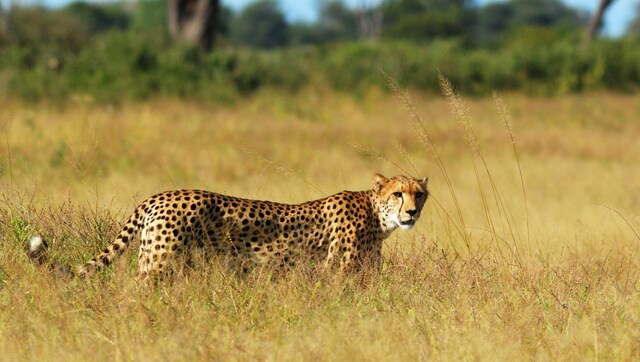This is why Kuno-Palpur National Park will be a good home for African cheetahs
Plans to bring cheetahs to India had begun several years ago. A total of 10 areas in Madhya Pradesh, Chhattisgarh, Rajasthan, Gujarat and Uttar Pradesh were monitored from 2010 to 2012

Cheetahs were last seen in India seven decades ago in the Sal forests of Chhattisgarh's Koriya district
Morena (Madhya Pradesh): After a gap of seven decades, the majestic cheetah will again prowl the jungles of India. Eight cheetahs have been brought to India from Namibia, Africa. The Kuno-Palpur National Park in Madhya Pradesh is now their new address.
Prime Minister Narendra Modi himself uncaged the cheetahs on Saturday during celebrations of his 72nd birthday.
But why was this particular park chosen for African cheetahs?
Plans to bring cheetahs to India had begun several years ago. A total of 10 areas in Madhya Pradesh, Chhattisgarh, Rajasthan, Gujarat and Uttar Pradesh were monitored from 2010 to 2012. But finally Kuno in Madhya Pradesh was chosen as the new address for the cheetahs. The Wildlife Institute of India and the Wildlife Trust of India took into account various factors such as weather, food, population of wild animals etc before taking a call.
What are the reasons behind choosing the Kuno-Palpur National Park for the cheetahs?
1) The Kuno-Palpur National Park is spread over an area of 748 square kilometers. Cheetahs were last seen in India seven decades ago in the Sal forests of Chhattisgarh’s Koriya district. The Kuno-Palpur National Park is not far from that place.
2) Cheetahs do not usually kill humans. But the world’s fastest animal needs a lot of space to live. They cannot live in densely populated areas. Cheetah wants quiet and vast dense green forest. The number of forests in India is less. The Kuno-Palpur National Park in Madhya Pradesh is one of them. Residents of 24 villages were evacuated to shelter wild animals here.
3) Planning in on to house four types of ferocious predators in Kuno. These include tigers, lions, cheetahs and leopards. The government has taken several steps to make their coexistence possible. India currently has lions only in Gujarat. They may also have a second address in Kuno.
4) Apart from this, some fears behind the release of cheetahs have also worked in the minds of experts. There are many leopards in the forests of Kuno. Statistics say that there are nine leopards per 100 square kilometers. The possibility of conflict between these animals with cheetahs brought from Africa cannot be ruled out.
In case of such conflicts, the cheetahs may be at risk because leopards are relatively stronger. However, the co-existence of leopards and cheetahs is not rare.
There are currently 21 cheetah habitats in the Kuno-Palpur National Park. If necessary, there will be space for 36 cheetahs in Kuno. According to official sources, cheetahs initially selected from Kuno may be sent to other forests to increase the number of cheetahs.
Read all the Latest News, Trending News, Cricket News, Bollywood News,
India News and Entertainment News here. Follow us on Facebook, Twitter and Instagram.
also read

Cheetahs return to India: When animals were brought back from the brink of extinction
India welcomed back cheetahs after they went extinct in the country over 70 years ago. However, other nations have successfully reintroduced animals — such as the wild bison, the lynx, red kites and more — in the past

Firstpost Podcast: Why did India need to import Cheetahs?
Why are eight cheetahs being brought to India? Tune in to find out

Cheetahs to travel empty stomach from Namibia to India, here's why
Eight cheetahs will be brought to Jaipur in Rajasthan from Namibia in Africa on 17 September in a cargo aircraft as part of an inter-continental translocation project and flown to the Kuno-Palpur National Park in Sheopur district the same day